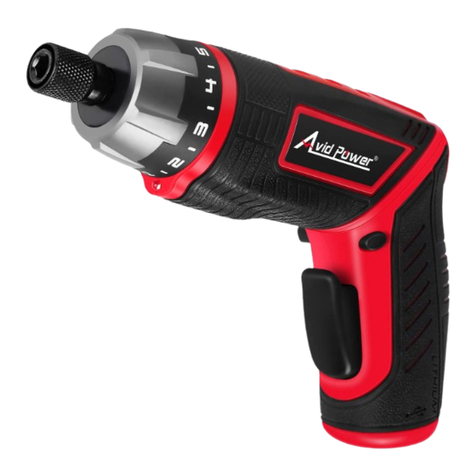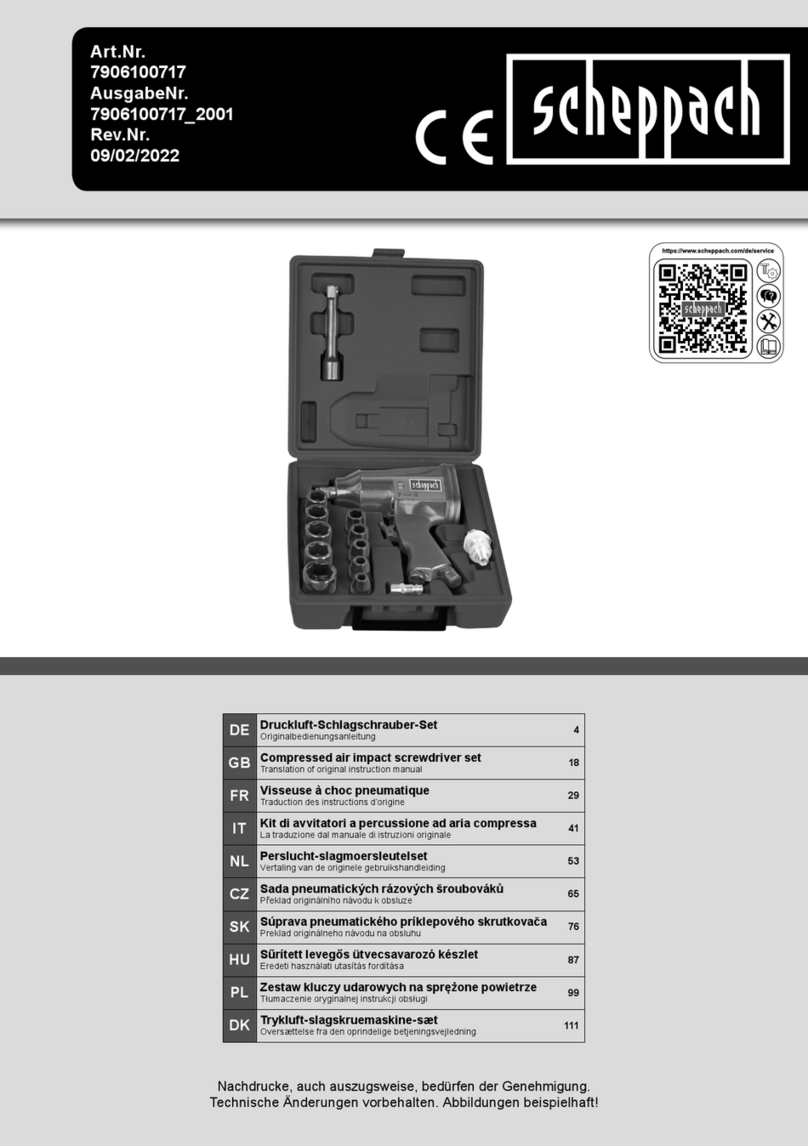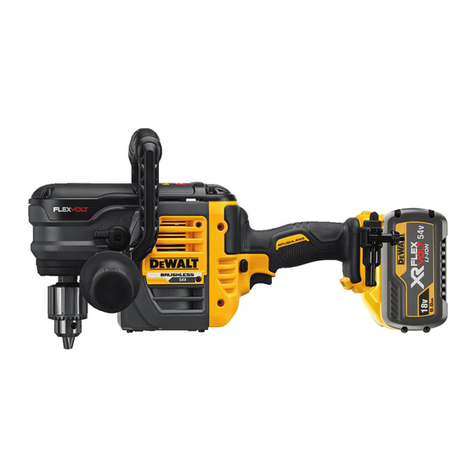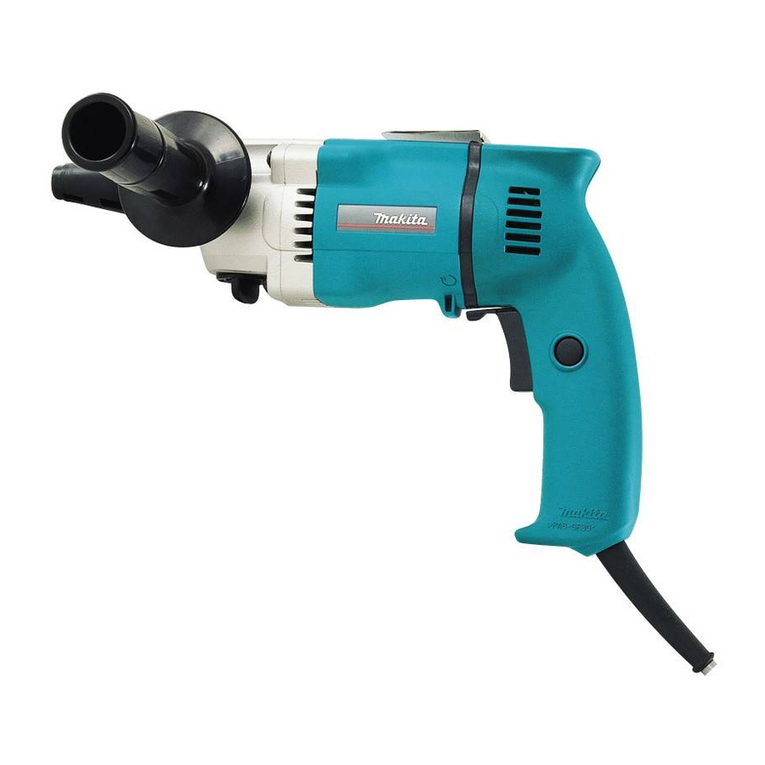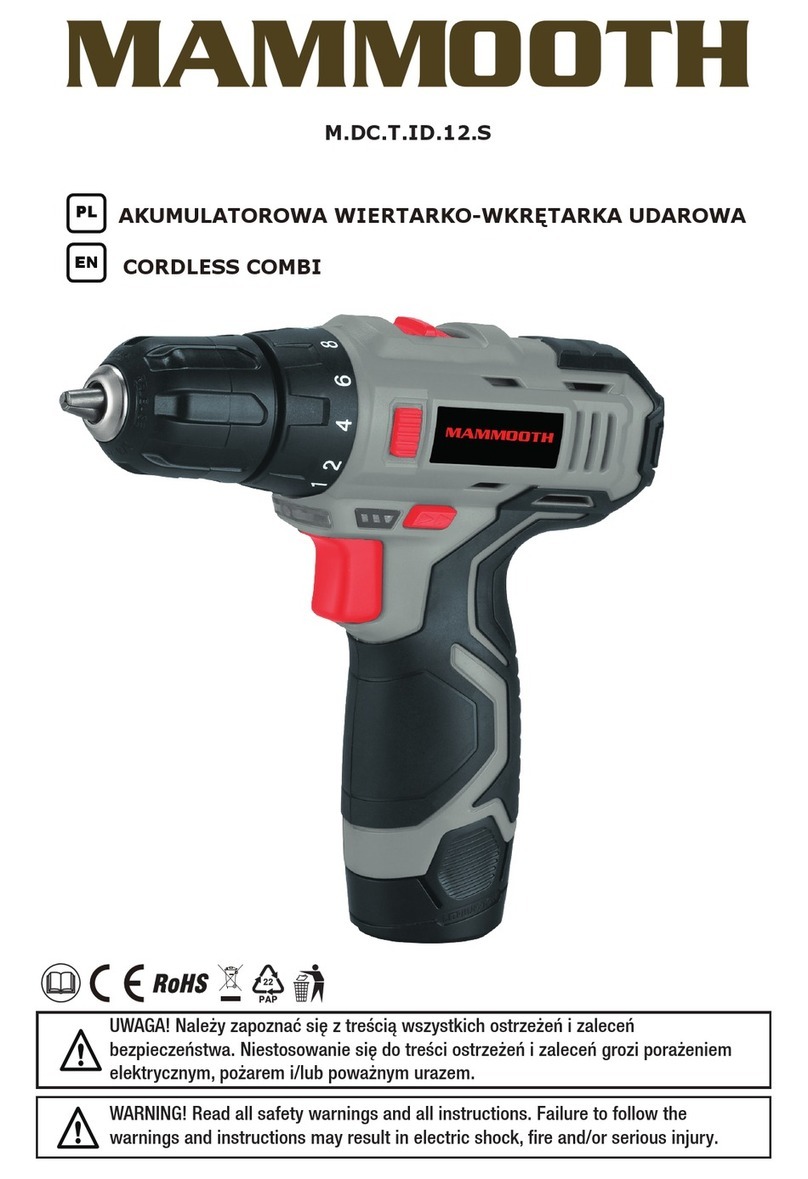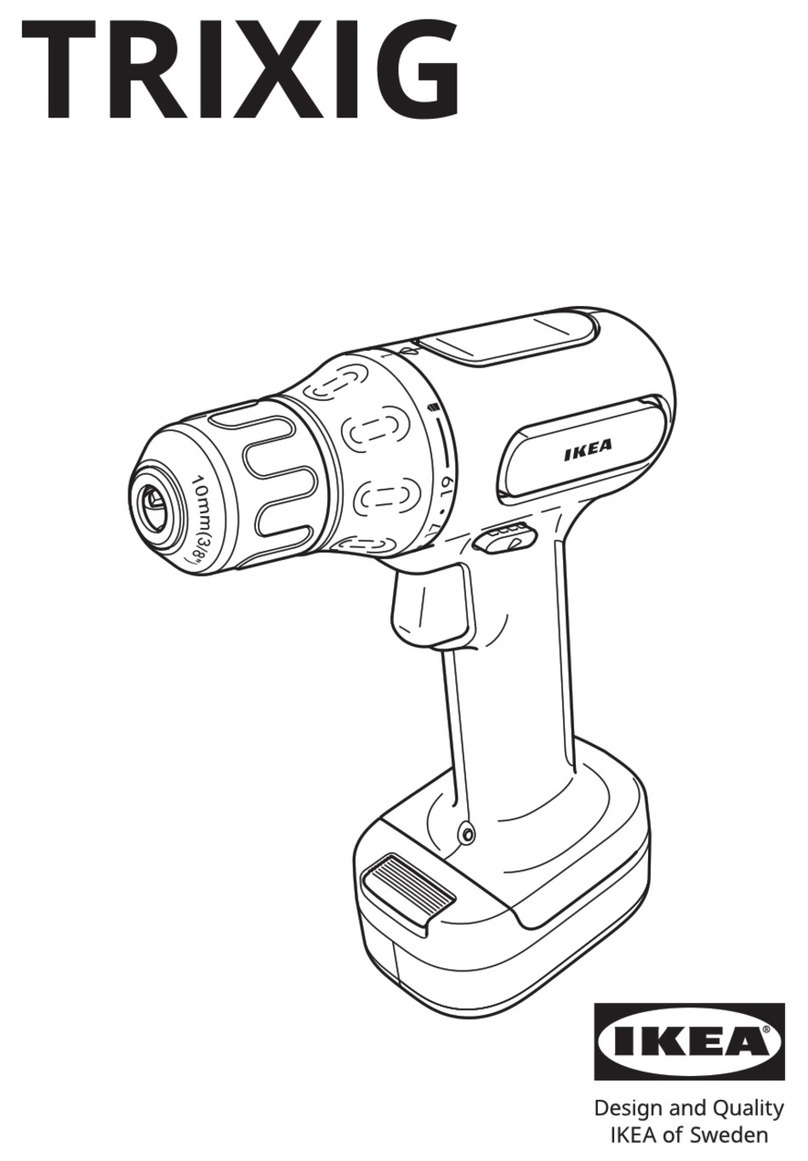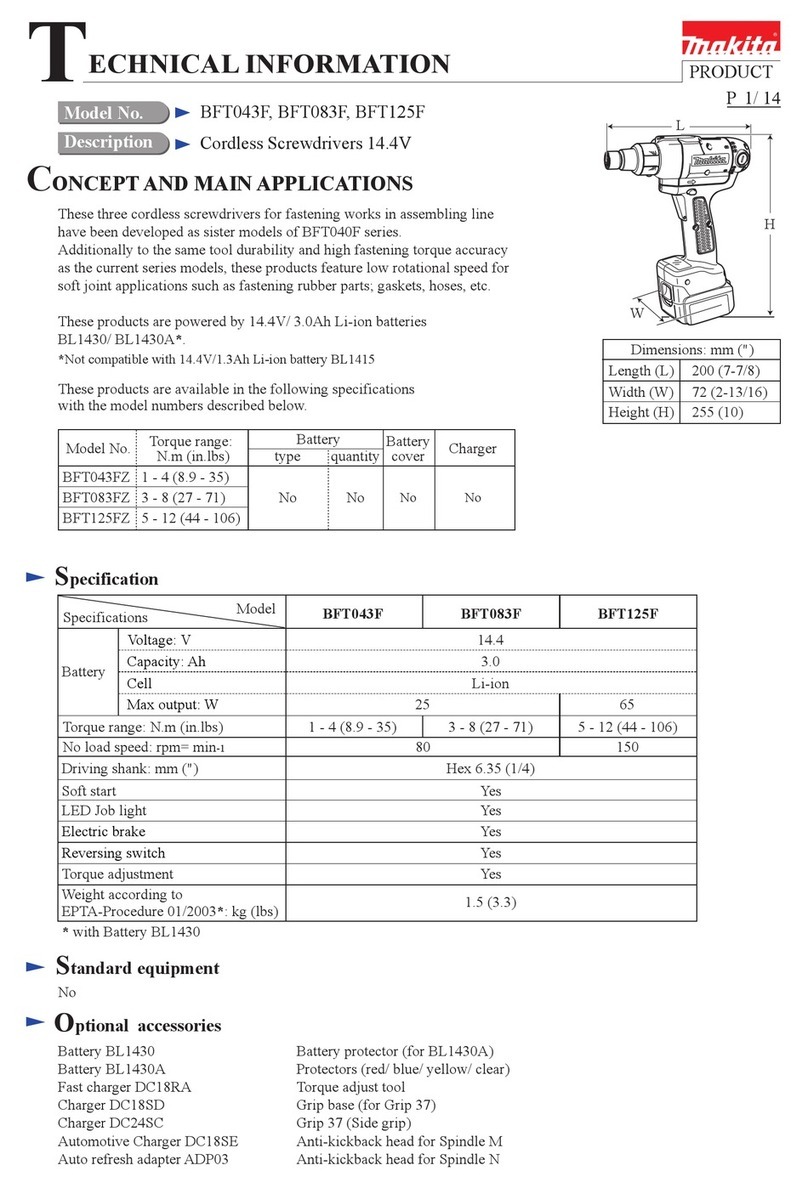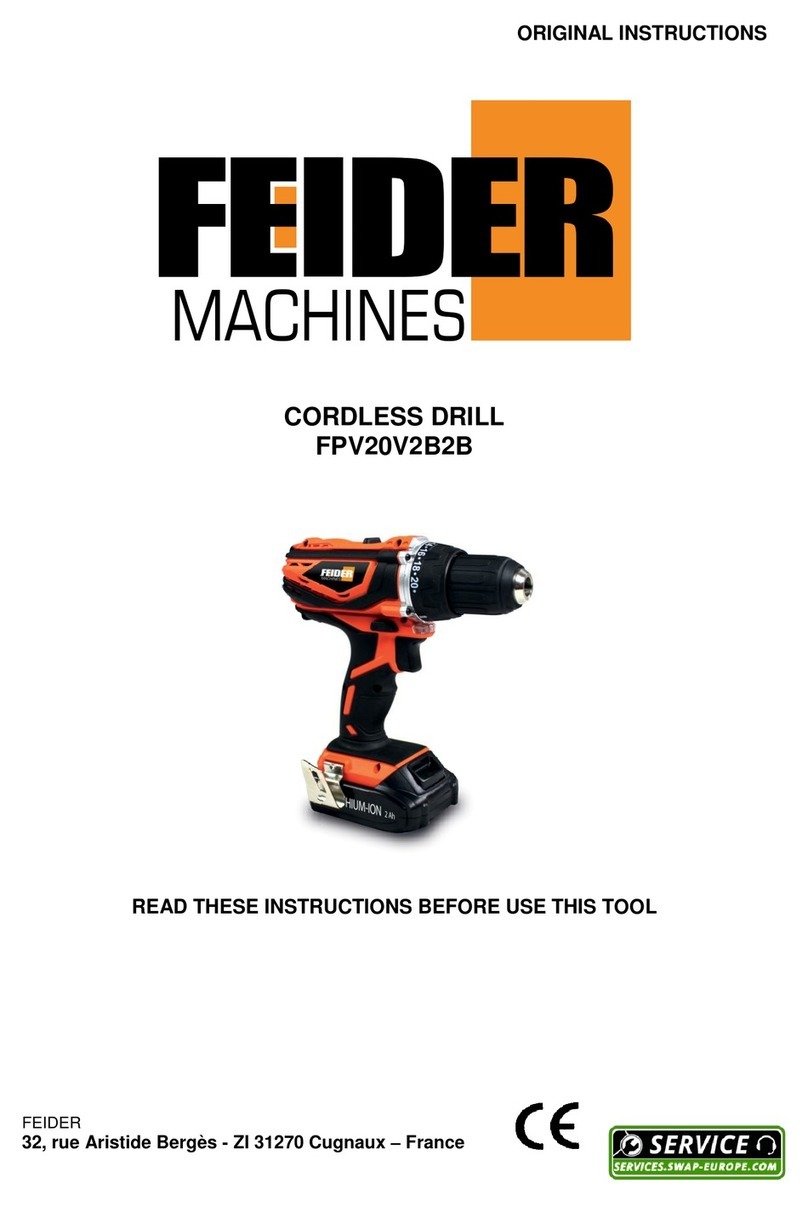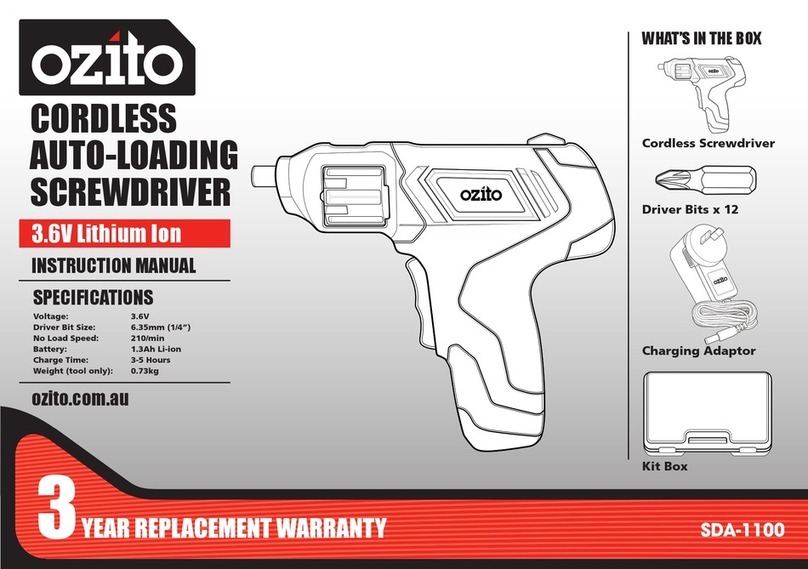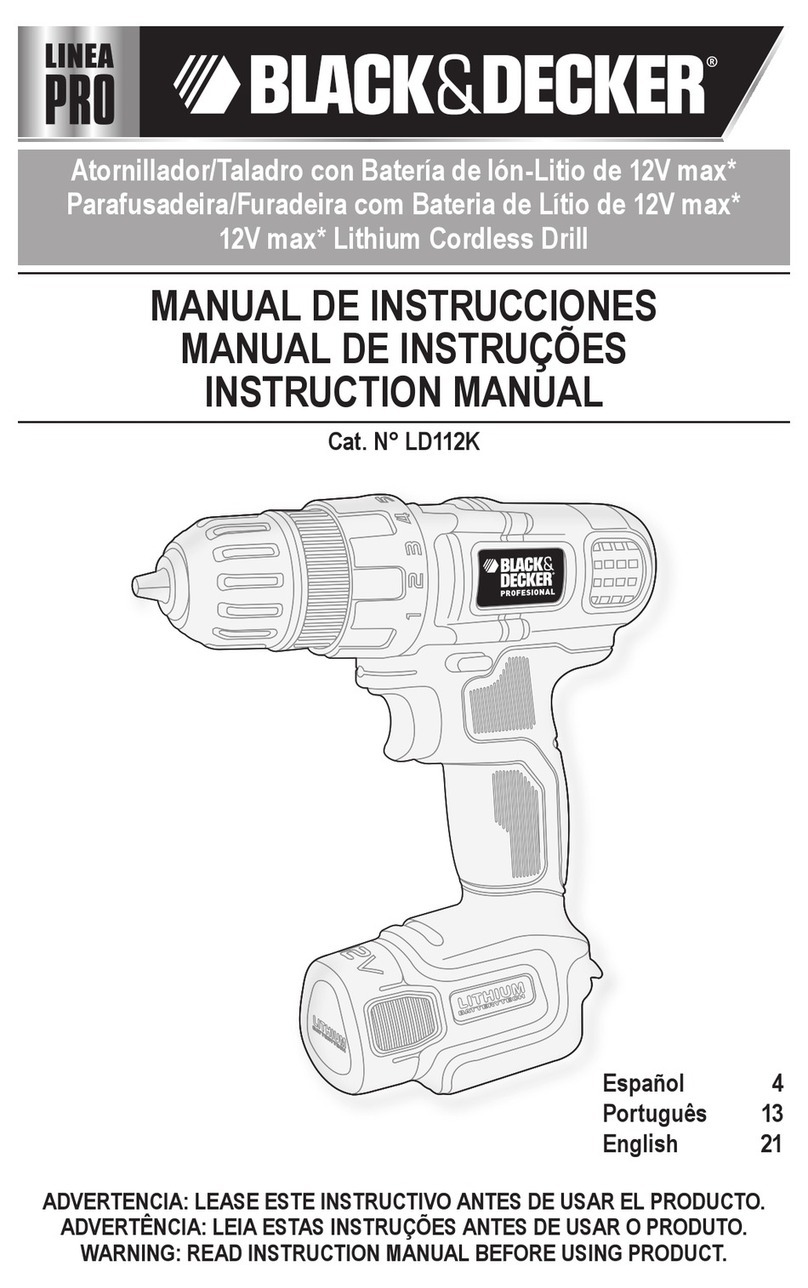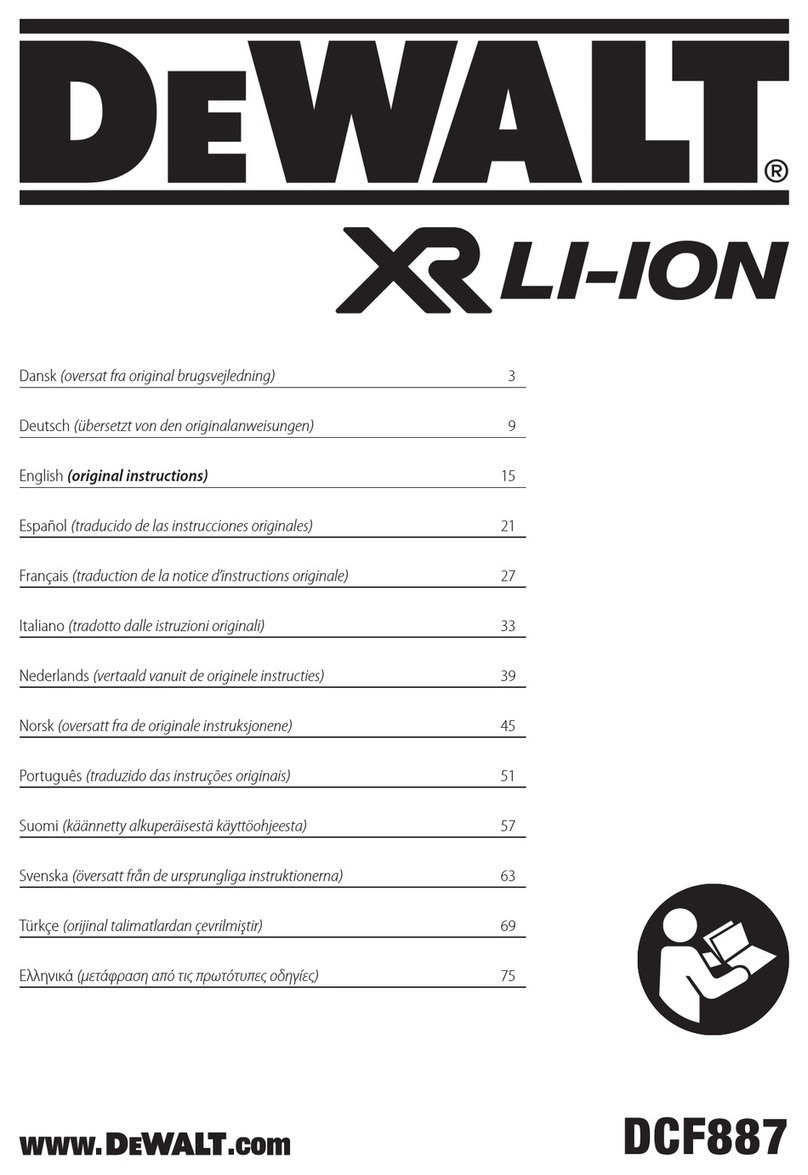Avid Power ACD306-N User manual

12V CORDLESS DRILL/DRIVER
SAVE THIS MANUAL
You will need this manual for safety instructions, operating procedures and warranty.
Put this manual and the original sales receipt in a safe dry place for future reference.
Operator's Manual
MODEL: ACD306-N/
ACD306-P

1
IMPORTANT SAFETY INSTRUCTIONS-------------------------------------------P.2
PRECAUTIONS FOR BATTERY CHARGER ------------------------------------P.6
SAFETY PRECAUTIONS FOR DRIL---------------------------------------------- P.7
PRODUCT SPECIFICATION----------------------------------------------------------P.8
CONPONENTS --------------------------------------------------------------------------P.9
PACKAGE INCLUDED ----------------------------------------------------------------P.9
OPERATION ------------------------------------------------------------------------------P.10
ADJUSTMENT ---------------------------------------------------------------------------P.14
MAINTENANCE -------------------------------------------------------------------------P.17
PART LIST --------------------------------------------------------------------------------P.18
SCHEMATIC DRAWING --------------------------------------------------------------P.19
TABLE OF CONTENTS

2
IMPORTANT SAFETY INSTRUCTIONS
1. KEEP THE WORK AREA CLEAN. Clean areas prevent injuries.
2. CONSIDER THE WORK AREA ENVIRONMENT. Don’t use power tools in
damp, wet, or poorly lit locations. Don’t expose your tool to the rain. Keep
the work area well lit. Don’t use tools in the presence of flammable gases or
liquids.
3. KEEP CHILDREN AWAY. All children should be kept away from the work
area. Don’t let them handle machines, tools and extensions cords.
4. STORE UNUSED EQUIPMENT. Store equipment in a dry area to inhibit
rust. The equipment also should be in a high location or locked up to keep
out of the reach of children.
5. DON’T FORCE THE TOOL. It will do the job better and more safely at the
rate for which it was intended.
6. USE THE RIGHT TOOL. Don’t force a small tool or attachment to do the
work of a larger industrial tool. Don’t use a tool for a purpose for which it
was not intended.
WARNING: When using electric tools, machines or equipment, basic safety
precautions should always be followed to reduce the risk of fire, electric shock, and
personal injury. The warnings, cautions, and instructions detailed in this manual
cannot cover all possible conditions and situations that occur.

3
IMPORTANT SAFETY INSTRUCTIONS
7. DRESS PROPERLY. Don’t wear loose clothing or jewelry, they can get
caught in moving parts. Protective, non-electrically conductive gloves and
non-skid footwear are recommended when working. Wear protective hair
covering to contain long hair and keep it from harm.
8. USE EYE PROTECTION. Use a full face mask if the work you’re doing
produces metal filings, dust or wood chips. Goggles are acceptable in other
situations. Wear a clean dust mask if the work involves creating a lot of fine
or coarse dust.
9. DO NOT TOUCH BITS OR BLADES WITH HANDS AFTER USE. They can
become extremely hot after the job is completed.
10. SECURE WORK. Use clamps or a vise to hold the work if possible. It’s
safer than using your hands and it frees both hands to operate the tool.
11. DON’T OVERREACH. Keep proper footing and balance at all times. Do
not reach over or across machines that are running.
12. MAINTAIN TOOLS WITH CARE. Keep tools sharp and clean for better
and safer performance.
13. Follow instructions for lubricating and safe performance. Follow
instructions for lubricating and changing accessories. Keep handles dry,
clean and free from oil and grease.
14. REMOVE ALL ADJUSTING KEYS AND WRENCHES. Make it a habit to
check that keys and adjusting wrenches are removed from any rotating tool

4
before using it.
15. AVOID UNINTENTIONAL STARTING. Don’t carry tools with a finger on
the switch. Be sure the direction switch is in the STOP position when not in
use or when changing attachments.
16. STAY ALERT. Watch what you are doing & use common sense. Don’t
operate any tool when you are tired.
17. CHECK FOR DAMAGED PARTS.
1) Before using the tool, any part that is damaged should be carefully
checked to determine that it will operate properly and perform its intended
function.
2) Check for alignment of moving parts, binding of moving parts, breakage
of parts, mountings, and other conditions that may affect its operation.
3) Check bits and blades to make sure they are sharp and not chipped.
Inspect screws and tighten any ones that are loose.
4) Any part that is damaged should be properly repaired or replaced by an
authorized service center unless otherwise indicated elsewhere in the
instruction manual. Have defective switches replaced by an authorized
service center? Don’t use the tool if the switch does not turn on and off
properly.
18. GUARD AGAINST ELECTRIC SHOCK. Prevent body contact with
grounded surfaces such as pipes, radiators ranges, and refrigerator

5
PRECAUTIONS FOR BATTERY CHARGER
enclosures. When drilling or cutting into walls, floors, or wherever “live”
electrical wires may be, try to ascertain whether there is a danger of shock.
19. REPLACEMENT PARTS. When servicing, use only identical replacement
parts.
CHARGE BATTERY AT LEAST 6 HOURS before initial use.
1. CHARGE AT ROOM TEMPERATURE. The room temperature must be
higher than 32°F and lower than 104°F.
2. DO NOT CHARGE IF THE CHARGER’S CORD OR PLUG IS DAMAGED.
Charging with a damaged cord may result in a fire or electrical shock. If the
charger is damaged in any way, have it repaired by a qualified serviceman.
3. USE WITH CAUTION, when coming into contact with items that can cause
an electrical short, such as paper clips, nails, the sides of a metal toolbox.
4. DO NOT INCINERATE THE BATTERY. This product has been carefully
engineered and manufactured to give you dependable operation. Please
read this manual thoroughly before operating your new product, as it
contains the information you need to become familiar with its features and
obtain the performance that will bring you continued use for many years.
1. Wear ear protectors when impact drilling. Exposure to noise can cause
SAFETY PRECAUTIONS FOR 12V DRILL

6
hearing loss.
2. Hold power tool by insulated gripping surfaces, when performing an
operation where the cutting accessory may contact hidden wiring.
3. Special Safety Instructions for Battery Pack and Charger. If under extreme
conditions any electrolyte should escape from the battery, it's essential to
avoid contact with skin. If electrolyte does come into contact with your skin,
rinse it off with water. In the event of electrolyte contact with your eyes, it's
essential to consult a doctor.
4. Before the use of the charger and the battery pack, read the instruction
manual for it carefully.
5. During the charging process, the current used should correspond to the
current of the battery charger.
6. Never let moisture, rain or splashed water reach the charging location. The
ambient temperature must not exceed 40℃.
7. Battery packs, which are defective or damaged or can no longer be
recharged, must be disposed of as hazardous waste. Hand them over at a
special collection point. Never harm our environment. Do not throw
unusable battery pack away into the domestic waste, into fire or into water.
8. If the electrical cable is damaged, the wire may only be replaced by the
supplier or by his repair workshop. Have repairs carried out only by an
authorized specialist.

7
9. Use only the battery pack, which has been produced by the original
manufacturer.
10. Always keep the surface of the charger free from dust and dirt.
11. Insert the battery pack into the charger. Follow the guidelines provided
concerning polarity.
12. Always remove battery pack before working on the machine.
13. When the battery pack is outside the drill, cover the contacts to avoid
short circuits (e.g. from tools).
14. Do not throw Li-ion batteries into water or fire, risk of explosion!
15. Protect the battery pack from impacts, and don't open it.
16. Never discharge the battery pack completely and recharge occasionally if
not used for a prolonged period.
Model ACD306
Voltage 12V
Charge Time
Battery Capacity 1.3Ah
Keyless chuck 3/8’’(10mm)
Adjustable Torque Setting 15+1
No Load Speed 0-350RPM/0-1250 RPM
Weight 3.1pounds
Product Dimensions 9.2 x 8.9 x 2.9 inches
PRODUCT SPECIFICATION
3 - 5 Hours

8
1. Keyless chuck
2. Torque settings
3. Variable speed trigger switch
4. Trigger lock
5. Build in work light
6. Gear shifter
7. Rubberized grip
8. Battery pack
9. Battery release tags
A. Charger
B. Charger stand
C. Flexible shaft
D. Extended bar
E. 10pcs drill bits
F. 10pcs driver bit
PACKAGE INCLUDED
TOOL CONPONENTS

9
How to install/remove the battery pack
1. Release battery pack from tool by pressing on both sides of the battery
release tabs and pull downward (Fig.2).
2. To insert battery, align battery and slide battery pack into tool until it locks
into position. Do not force.
(Note: If battery release tabs are cracked or damaged, do not insert into tool.
Battery can fall out during operation.)
1. Cordless drill 3. Release button
2. Battery pack
OPERATION

10
CAUTION: Fully charge battery before first use. The battery will reach full
capacity after being charged and discharged several times.
CAUTION: Avoid short periods of charging. Only charge the battery pack when
completely empty.
CAUTION: Adaptor, charger and battery pack will be warm when charging.
How to charge the battery pack (Fig.3)
1. Insert the AC/DC adaptor into the household current receptacle. The green
light is on. The green light is the power indicator.
2. Properly insert the battery pack into the charging stand. Make sure it is
placed correctly(+ and -). The red light is on. The red light is the charge
indicator.
3. Normal charging time is 3-5 hours. When the battery is fully charged, the
red light will turn off.
4. When charging more than one battery pack in succession, allow 15
minutes between charges.
OPERATION

11
METHOD 1 (Fig.4)
To install the driver bit/drill bit:
Step 1: Rotate the chuck (A) anticlockwise by hand to open the chuck jaws. (If
A was screwed too tight, please rotate it with more force).
Step 2: Place the driver/drill bit in the chuck as far as it will go.
Step 3: Then rotate the chuck (A) clockwise by hand to tighten the chuck
jaws.
Do it in reverse to remove the driver bit/drill bit.
OPERATION

12
METHOD 2(Fig.5 Fig.6 Fig.7)
To install the driver bit/drill bit:
Step 1: Open the chuck jaws: move the forward/reverse button to the right
side of the tool to make it do reverse rotation.
Step 2: Hold the keyless chuck with one hand and squeeze the trigger with
the other hand to open the chuck jaws.
Fig.5
Fig.6
OPERATION

13
Step 3: Carefully center the driver bit/drill bit between the jaws.
Step 4: Move the forward/reverse button to the left side, it will do forward
rotation.
Step 5: Hold the keyless chuck with one hand and squeeze the trigger slowly
until it is locked in place.
Do it in reverse to remove the driver bit/drill bit.
NOTE: This drill is compatible with the accessories of other brands. However,
since the drill chuck is 3/8 inch, the diameter of drill bits/driver bits you
purchase cannot exceed 3/8 inch.
REVERSING SWITCH (Fig.8)
1. The reversing switch determines the rotational direction of the tool and also
ADJUSTMENT
Close
Fig.7
Open

14
serves as a lock-off button. You can choose between clockwise and
anticlockwise rotation. To avoid causing damage to the gearing it is
advisable to change the direction of rotation only when the tool is at a
standstill.
2. To select forward rotation, release the trigger switch and depress the
forward/reverse control button on the right side of the tool.
3. To select reverse rotation, depress the forward/reverse control button on
the left side of the tool.
NOTE: The first time the tool is run after changing the direction of rotation, you
may hear a click on start up. This and the impacting noise that the tool makes is
normal and does not indicate a problem.
GEAR SHIFTING (Fig.9)
The tool is equipped with two separate gear ranges, low gear, and high
gear. Low gear provides high-torque and slower drilling speeds for
heavy-duty work or for driving screws. High gear provides faster speeds

15
for drilling lighter work.
A) Select LOW speed for applications requiring higher power and torque.
B) Select HIGH speed for fast drilling, drilling or driving applications.
NOTE: Never change speeds while the tool is running. Failure to obey this caution
could result in serious damage to the drill.
NOTE: If you have difficulty changing from one gear range to the other, turn the
chuck by hand until the gears engage.
Torque adjustment collar(Fig.1)
The torque can be adjusted in 0-15 graduation by turning the adjusting
collar. Circling the collar are numbers and a drill bit symbol. These
numbers are used to set the clutch to deliver a torque range. The higher
the number on the collar, the higher the torque and the larger the fastener
ADJUSTMENT

16
which can be driven. To select any of the numbers, rotate until the desired
number aligns with the arrow.
NOTE: Before the actual operation, drive a trial screw into your material or a
piece of duplicate material to determine which torque level is required for a
particular application.
Trigger Switch (Fig.10)
To turn the tool on, squeeze the trigger switch . To turn the tool off, release
the trigger switch. The chuck will stop as soon as the trigger switch is fully
released. The variable speed switch enables you to select the best speed
for a particular application. The more you squeeze the trigger, the faster
the tool will operate. Use lower speeds for starting holes without a center
punch, drilling in metals or plastics, or driving screws. For maximum tool
life, use variable speed only for starting holes or fasteners.
Trigger
Fig.10

17
ATTENTION: Always remove the battery before carrying out any work on the
machine.
1. To clean, always use a dry or moist, but not wet towel. Many cleaning
agents contain chemical substances which may cause damage to the plastic
parts of the machine. Therefore do not use any strong or flammable cleaners
such as gas, paint thinner, turpentine or similar cleaning agents.
2. Always keep air ventilation holes free of dust deposits to prevent overheating.
3. Keep the vents clear of dust and debris. This will help prevent possible
electrical shorts and ensure proper cooling.
4. Keep the tool housing and handle clean and free of oil and grease by using
mild soap and a damp (not wet) cloth.
5. Avoid overloading your drill. It will become hot and lose efficiency. Running it
free of load for a minute or two will allow it to cool itself to normal temperature.
6. Inspect the cord regularly and have it replaced by an authorized repair
facility if it is damaged.
7. Lubrication for this tool is done at the factory and should not be necessary
again under normal use.
8. An authorized repair center should do any repairs, modification, or
maintenance that involves disassembling the grinder.
9. Any damage to the tool should be corrected at an authorized repair center.
MAINTENANCE

18
NO.
DESCRIPTION
NO.
DESCRIPTION
1
Shift button
24
Steel pillar
2
Spring
25
Washer
3
Housing
26
Gear ring
4
Plate spring
27
Ring
5
LED light
28
Steel ball
6
F/R button
29
Shaft
7
Trigger switch
30
Sleeve
8
Motor
31
Screw
9
Gear
32
Keyless chuck
10
Cover
33
Torque setting ring
11
Screw
34
Screw
12
Washer
35
Front cover
13
Inner gear
36
Press ring
14
Planet gear
37
Spring
15
Gear holder
38
Cir clip
16
Planet gear
39
Washer
17
Gear holder
40
Steel ball
18
Gear ring
41
Spring washer
19
Ring
42
Pin
20
Pin
43
Screw
21
Planet gear
44
U clip
22
Gear holder
45
Battery connector
23
Spindle lock block
46
Battery pack
PART LIST

19
SCHEMATIC DRAWING
This manual suits for next models
1
Table of contents
Other Avid Power Power Screwdriver manuals

